

Fukushima fuel melt confirmed. Investigations at unit 1 at Fukushima Daiichi suggest that most of the fuel in the reactor core melted and dropped to the bottom of the reactor vessel in the early stages of the accident.
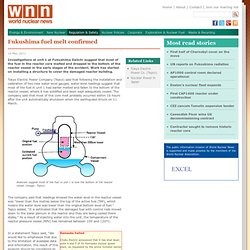
Work has started on installing a structure to cover the damaged reactor building. Tokyo Electric Power Company (Tepco) said that following the installation and calibration of two new water level gauges, water level readings suggest that most of the fuel in unit 1 had earlier melted and fallen to the bottom of the reactor vessel, where it has solidified and been kept adequately cooled. The company said that most of this core melt probably occurred within 16 hours after the unit automatically shutdown when the earthquake struck on 11 March. Fukushima, risk, and probability: Expect the unexpected. We continue to populate our planet with technologies that have catastrophic potential.
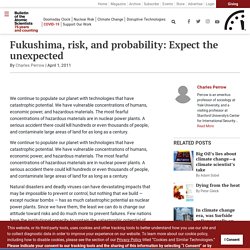
We have vulnerable concentrations of humans, economic power, and hazardous materials. The most fearful concentrations of hazardous materials are in nuclear power plants. A serious accident there could kill hundreds or even thousands of people, and contaminate large areas of land for as long as a century. Natural disasters and deadly viruses can have devastating impacts that may be impossible to prevent or control, but nothing that we build — except nuclear bombs — has as much catastrophic potential as nuclear power plants.
Since we have them, the least we can do is change our attitude toward risks and do much more to prevent failures. Currently our approach to risk is “probabilistic,” and the probability of a tsunami seriously damaging the Fukushima Daiichi plant was extremely small. Futami was not alone in his thinking. Large earthquakes. Large tsunamis. Power outages. Containment failure. Japan Nuclear Disaster Caps Decades of Faked Reports, Accidents. The unfolding disaster at the Fukushima nuclear plant follows decades of falsified safety reports, fatal accidents and underestimated earthquake risk in Japan’s atomic power industry.
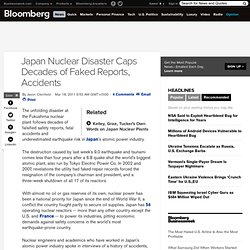
The destruction caused by last week’s 9.0 earthquake and tsunami comes less than four years after a 6.8 quake shut the world’s biggest atomic plant, also run by Tokyo Electric Power Co. In 2002 and 2007, revelations the utility had faked repair records forced the resignation of the company’s chairman and president, and a three-week shutdown of all 17 of its reactors. With almost no oil or gas reserves of its own, nuclear power has been a national priority for Japan since the end of World War II, a conflict the country fought partly to secure oil supplies. FEPCO Statement on Fukushima. Am pleased to be back in the US, safe and sound with my family.

(Note to reporters: Stop sounding disappointed; it pisses me off.) Another FEPC Statement. Another statement from FEPC.

My comment: TEPCO is fighting the good fight, continuing to inject seawater into Units 1 and 2. TEPCO has suspended seawater injection on Unit 3 after the explosion. That looks very bad. Crisis continues at Fukushima nuclear plant as fuel rods exposed again. Loss of coolant at Fukushima Daiichi 2. FIRST PUBLISHED: 6.14pm UPDATE 1: 8.04pm Information from Tepco television appearance Serious damage to the reactor core of Fukushima Daiichi 2 seems likely after coolant was apparently lost for a period.

Seawater is again being injected, but coolant level is unknown. A spokesman for Tokyo Electric Power Company has appeard on national broadcaster NHK to explain the company's efforts to control unit 2's reactor core after its isolation cooling system failed following an increase in containment pressure to some 700 kPa. Fukushima Nuclear Accident – 15 March summary of situation. The situation surrounding the Fukushima Nuclear Accident, triggered by Japan’s largest recorded earthquake and the resulting 10 m high tsunami, continues to develop rapidly.
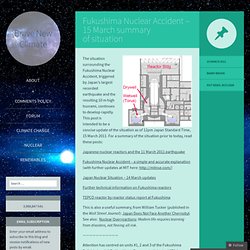
This post is intended to be a concise update of the situation as of 12pm Japan Standard Time, 15 March 2011. For a summary of the situation prior to today, read these posts: Japanese nuclear reactors and the 11 March 2011 earthquake Fukushima Nuclear Accident – a simple and accurate explanation (with further updates at MIT here: Japan Nuclear Situation – 14 March updates Further technical information on Fukushima reactors TEPCO reactor by reactor status report at Fukushima. Jeffrey Lewis: We seem to be into millisi... Update on Japan Earthquake. Updates of 2 June 2011 Staff Report.
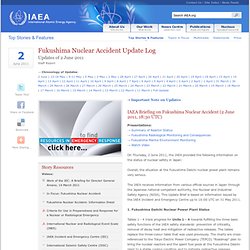
Japan › ISIS Statement on Events at Fukushima Daiichi Nuclear Site in Japan. March 15, 2011 ISIS assesses that the situation at the Fukushima Daiichi nuclear plant has worsened considerably.

The explosion in the Unit 2 reactor, the third so far, and the fire in the spent fuel pond in the reactor building for Unit 41 means that this accident can no longer be viewed as a level 4 on the International Nuclear and Radiological Events (INES) scale that ranks events from 1 to 7. A level 4 incident involves only local radiological consequences. This event is now closer to a level 6, and it may unfortunately reach a level 7.
A level 6 event means that consequences are broader and countermeasures are needed to deal with the radioactive contamination. Page van der Linden: RT @HirokoTabuchi: Contrar... Jeffrey Lewis: So, is this the point wher... Most Recent FEPC Statement. FEPC has released another update.

Not great news. The cores are all at least partially exposed. The water temperature in the spent fuel pond is 183 degrees Fahrenheit — close to boiling. The fact sheet contains a small amount of editorializing, comparing the one hour dose at the main gate to a chest CT scan. Keep in mind that a chest CT scan results in a much higher dose than a traditional X-Ray and there is some controversy about the societal risk from unnecessary CT scans. Problems for units 3 and 4. FIRST PUBLISHED 0.25am GMTUPDATE 1:14am GMT Information from TEPCO spokesman and video feed. Attempts to refill fuel ponds. FIRST PUBLISHED: 4.25am GMT UPDATE 1: 9.29am GMT Temperature, radiation data and contextUPDATE 2: 10.00am GMT Further temperature dataUPDATE 3: 1.41pm GMT Fire trucks in action UPDATE 4: 4.53pm GMT Image and results of spraying A major struggle took place today to maintain cooling of used nuclear fuel at Fukushima Daiichi 3 and 4.
Helicopters made water drops and large fire trucks showered the buildings. Initial indications are that the effort was successful. While unit 3 was in operation when the earthquake struck on 11 March, and has been in trouble since the tsunami took out emergency diesel generators, unit 4 was fully shut down at that time and had appeared to remain safe until 16 March when an explosion led to fires.
Another FEPC Statement. Jeffrey Lewis: Am led to understand that... Dan Yurman: World Nuclear News: Some p... Fuel pond work at Fukushima. ORIGINALLY PUBLISHED: 11.38am GMT CORRECTION: 1.16pm GMT Correct number and size of holes. Clarity on hydrogen productionCLARIFICATION: 8.15pm GMT Removing the word 'vent' to avoid confusion with reactor vessel venting Recent work at Fukushima Daiichi has included making holes to allow hydrogen to disspate from fuel ponds at units 5 and 6, while unit 3's fuel pond is said to have stabilised.
An announcement of stability at unit 3's pond came from chief cabinet secretary Yukiyo Edano. This follows the deployment of Hyper Rescue, a truck featuring a 22 metre arm that pumps some 3000 litres of water per minute, in combination with Super Pump Truck. Police riot trucks and army fire engines had already been working on the job. Edano made clear that unit 3 remains a concern and that spraying may continue. Units 5 and 6. Press Releases. Operation Tomodachi is under way. Photo courtesy US Pacific Fleet Check out the pics from the US Pacific Fleet at their Flickr site. Too bad the Russians and Chinese can’t be bothered to lend either of their super-scary carriers to take part in relief efforts. It’s not like they’re next door or anything… "Starbuck" is the online moniker of Major Crispin Burke, a US Army aviator qualified in the UH-60 and LUH-72 helicopters.
Major Burke has served in the 82nd Airborne Division, 10th Mountain Division, and Joint Task Force-Bravo in Honduras. Fukushima Nuclear Plant, Viewed in NOTAMs. Photo courtesy of the US Pacific Fleet The aircraft carrier USS Ronald Reagan has pulled away from the shores of Japan, after detecting radioactive contamination on seventeen US sailors… …one hundred nautical miles away from the stricken Fukushima nuclear power plant. And the situation only seems to be getting worse, simply judging by the NOTAMs, or Notices to Airmen, published for the northeastern portion of Japan. In less than 72 hours, officials have gone from simply advising pilots to “avoid” flying within 10 kilometers of the Fukushima plant to declaring a prohibited area within 30 kilometers.